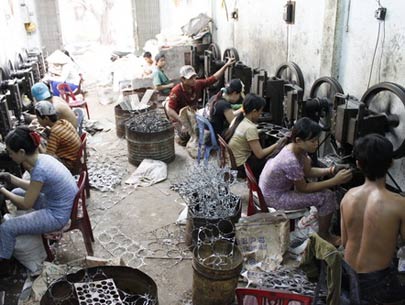Visual arguments have the potential to captivate its audience, seeing as though photos are worth a thousand words. Political cartoons, powerful photographs (such as the falling man, or the the last Jew in Vinnitsa) even well thought out warning adverts grab our attention, shock us, make us think, laugh and maybe even cry, somethings words usually lack the power to do. That doesn't mean that there aren't any bad visual arguments out there, for example, a image originating from the website,
Mediaviolence.org*; found in our textbook, " Practical Argument" on page 84. ( I tried to find this image online, but had no luck, it really shows how unremarkable and forgettable this image is. Before we look at what exactly this image does wrong, it is important to recognize the argument of this image, the audience it is aimed towards , and the agenda of the people pushing it.
The image, visually, is a simple one. A young boy, seemingly about 11 years old is deeply engrossed by the video game he is playing. He is sitting on a blue couch that is empty on his right side (a semi-important detail), and the rest of the frame is relatively simple with a gray background that is out of focus. Above the empty spot on the couch the there is a small list, showing the top 5 games in 2011 according to CNBC. We, as the audience are supposed to infer that the child is playing any one of these games. The image's statement being that these violent games, are having a hypnotizing effect on our children all around the world, keeping their attention on the violence in the game. This is a very clear-and-cut case of playing to our emotions. There is an attempt to support their claim with a logical argument, but it will be shown why it fails to hold up against any scrutiny. The previously mentioned detail empty hints to the missing parent that should be there with their child, keeping an eye on them. This also leads into the next point of the visual argument, the audience. This image was created to scare/shock parents that limit the control over their children's entertainment. The empty place on the couch is a position they will put themselves into metaphorically, encouraging them to reflect on how they are looking over the media their children interact with.
Now, its time to discuss how this visual argument falls short, and can be taken apart with only a little research. Lets start by analyzing the visual itself, the image of the boy on the couch playing the video game. It feels, at least in my opinion, that there was little effort or thought put into it. It feels like a stock image taken from the nooks and crannies of the internet. To be honest, I doubt that the boy being on a couch by himself was intentional, by the "designers" of this argument, to symbolize the missing parents in the child's life. The only part that I suspected they put in, the small list, isn't even accurate. According to meta gamer,(
http://www.metacritic.com/browse/games/score/metascore/year/all/filtered?year_selected=2011 ) the most reliable source of game rankings, none of the games mentioned made the top five. Sourcing a out of touch news site for information on video games is like asking a 90 year old what their favorite model of computer is, it would be rare if they could tell one apart from the other. The games mentioned on the list, except for Deus Ex 3, did mediocre at best, were not overly violent to be controversial, and fell out of memory within a month or two. Dues Ex 3's focus isn't even on violence ( although there are elements of violence and action). The focus is on its story driven narrative, about humanity struggling with class divides and how future technology fits into this struggle. One of the top 5 best games to come out that year was a puzzle based game called Portal 2**, with colorful, interesting characters, an engaging struggle, and heavy emphasis on thinking outside the box and careful examination of the environment to escape the facility that you are trapped in. Provided are some of the trailers showcasing, the environments, characters and concepts:
https://www.youtube.com/watch?v=dWTqylt3JQQ.
Over all, other then being misleading, this argument is not fair to its audience. The average parent that doesn't know anything about video games would not have the knowledge to do the small amount of research I did to debunk the list and its source. It also doesn't account for the different genre, narratives and focus of different games they aren't all the same cut and dry shooter game with an emphasis on killing. At most, this image would succeed in tricking and misleading parents into thinking that the video game media focuses mostly on violence, as that inaccurate top five list appears to show.
*I could not, for the love of me, find this picture on the website, or on google. Goes to show how stock it is huh?
** I would highly recommend both installments of this game, they are short, fun and challenging. They are both funny, engaging games and can be found for very cheap together at this point.
http://store.steampowered.com/bundle/234/


